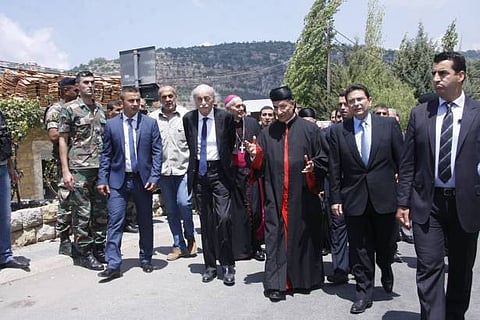Inauguration of Maronite church in Chouf seals reconciliation
In 2001 Druze and Maronite leaders signed a penance pact to allow displaced Christians back in Chouf

Beirut: Fifteen years on the efforts to reconcile the Maronite and Druze communities in the Chouf Mountains got a boost on Sunday with the inauguration of a Maronite Church in the village of Brih near Druze leader Walid Junblatt’s stronghold of Al Mukhtara.
In 2001, Junblatt and former Maronite Patriarch Mar Nasrallah Butros Sfeir signed a penance pact to allow Christians forcefully displaced during civil war battles that took place between militias of the predominantly Druze Progressive Socialist Party (PSP) and the Christian Lebanese Forces (LF) in the Chouf in 1983 to return.
Patriarch Mar Bisharah Butros Al Ra‘i marked the anniversary of the pact by holding a mass at Al Saydah Church in the presence of prominent political figures, including Junblatt, his son Taymur, LF deputy leader George Adwan, Lebanese Democratic Party leader Talal Arslan, former presidents Ameen Gemayel and Michel Sulaiman, the scion of a leading Maronite family Farid Haykal Al Khazen who financed the restoration of the house of worship, Army Commander General Jean Qahwaji, Papal Ambassador to Lebanon Gabriel Caccia, Hezbollah Deputy Ali Fayyad and scores of other dignitaries.
The Cardinal touched on key concerns in his homily, calling on Lebanon’s elites “to continue this conciliation and provide it with the spiritual, economic and social frameworks to protect the mountain area.”
In a veiled attack on the most recent failed National Dialogue sessions, the head of the Maronite Church insisted on the necessity to first elect a president before addressing other pending issues.
“What is the point of addressing issues before electing a head of state, … [the only person] authorised to tackle [constitutional] matters,” he inquired, aware that his utterances reflected grave preoccupations among many who perceived the most recent debates as a way to weaken all available constitutional mechanisms.
At a reception that followed mass, Junblatt expressed his hope that the Lebanese would heighten their awareness of regional threats “and find solutions to the country’s complicated problems by restoring the roles of state institutions.” It was ironic that he spoke these words in front of President Sulaiman sitting on the front row, aware that the PSP-supported Henri Helou candidacy — some called it the Manchurian Candidate — blocked Samir Geagea’s election on April 23, 2014, during the first and only ballot cast by parliamentarians in this cycle.
Although the architect of the Maronite-Druze reconciliation, Cardinal Sfeir, was absent from Sunday’s ceremonies, Junblatt praised the elderly cleric and reiterated that the conflict between the two communities would not be repeated. “At a time when wars are raging in the region and terrorism has surpassed the borders of countries and reached the whole world, we hold onto the reconciliation in Lebanon, which became a model for the world,” he hammered, and while he praised dialogue and coexistence as basic principles among the Lebanese, he skipped over many recent clashes that destabilised the country.
Attendees who spoke to media outlets stressed that if political reconciliation could occur among two major feudal parties that spared no one at the height of the civil war, that this could also “revive the state and its Constitutional institutions,” if current actors wished to. Few of the thousands of Christians who were forced to leave the Chouf in the early 1980s returned although the plan to bring them back gained momentum in 2014, which the rebuilding of the ransacked Brih church aimed to facilitate.
Long-standing tensions
During Lebanon’s civil war in the 70s and 80s, Druze sided with anti-Christian elements that led to ugly clashes.
However, Maronite-Druze disputes can be traced as far back as the 1860s during the Mount Lebanon civil war when Maronite peasants rose against their Druze feudal lords under Ottoman rule.
The rebellion resulted in the deaths of an estimated 20,000 Christians at the hands of the Druzes. At least 380 Christian villages and 560 churches were destroyed.
4,000 Druze were also killed in the bloody battles.
The Ottoman’s had signed a treaty in 1523 with Paris, permitting France to protect Arab Christians.
On August 3, 1860, France dispatched 12,000 European soldiers including Brits, to put an end to the massacres and bloodshed.
The clashes led to the formal creation of the Mount Lebanon Mutasarifiyyah on June 9, 1861, which granted semi-autonomy to the area, although it remained under Ottoman rule with Dawood Pasha as its leader, an Armenian Catholic Governor. Tensions between Maronites and Druzes eased somewhat but no one was spared the 1915-1918 Ottoman imposed embargo on food, which resulted in the deaths of half of Mount Lebanon’s population — then estimated at 400,000 — through famine.
Sign up for the Daily Briefing
Get the latest news and updates straight to your inbox



